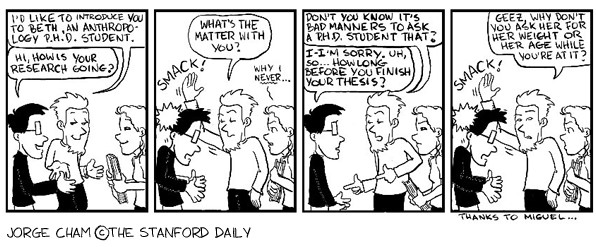
As explained in Tip 8, exploratory factor analysis may be a practical place to conclude a field research, However, PhD process demands a lot more academic rigor. Each of the extracted factors are tested rigorously in a confirmatory factor analysis / Structured Equation Modeling to ensure that the final model is a robust, rigorous and statistically acceptable.
The confirmatory aspect of a model is carried out using confirmatory factor analysis (CFA) – a multivariate regression procedure that is used to test how well the measured variables represent the hypothesized constructs. The CFA technique hypothesizes a set of parameters (factor loadings, correlations and uniqueness) and tests the model for its validity. To this end, a CFA procedure typically is designed as follows:
- Stage1 (CFA) : Developing the measurement model for individual constructs
- Stage 2 (CFA): Assess the model validity
- State 3 (CFA/SEM) : Develop the structure model for multivariate regression
In my research, the model was extracted from the UTAUT2 theory and initial test support came from the exploratory factor analysis. Model identification dictates that each measure should load on only one construct and there should be at least two items associated with each construct. In the SEM model each causal variable (independent variable) is called exogenous variable – and each effect variables ( dependent variable) is called the endogenous variable.
Stage 2 of CFA analysis is to assess the model validity. In this stage the theoretical model is compared with the reality model to see how well the data fits. To check the measurement model fit, a number of indicators are used (ref table 1).
If 3 or 4 of these indexes meet the required recommended value, the measured model is recommended for further analysis. I am sharing the fit indices recommended values and how the AMOS results fared for various indices in my research in the table 1 below
Table 1: Fit Indices for measurement model
| Goodness of Fit Measure | Recommended Value | Measurement Value | Result | |
| CMIN | Chi-square to df | <=3.0 | 2.084 | Good fit |
| CFI | Comparative Fit Index | >=0.9 | 0.935 | Good fit |
| RMSEA | Root Mean Square of Error Approximation | <=0.8 | 0.052 | Good fit |
| SRMR | Root Mean Square Residual | <=0.09 | 0.031 | Good fit |
| GFI | Goodness of fit index | >=0.9 | 0.899 | Borderline |
| AGFI | Adjusted Goodness of fit index | >=0.8 | 0.826 | Good fit |
As table 1 shows, there is an excellent model fit performance with 5 indices exceeding their respective common acceptance levels – and one indice on borderline fit. Hence, my research thesis accepted the model as a valid model on these parameters.
The next step in the model validation process is to evaluate the psychometric properties of the measurement model in terms of convergent validity and discriminant validity.
Convergent validity ensures that a particular item is designed to measure the construct it is supposed to measure. Average Variance Extracted (AVE) and Composite Reliability (CR) were proposed by (Fornell & Booksten, 1982) as measures to assess convergent validity.
As an example, Table 2 shares the AMOS results for the construct correlation matrix in my research.
Table 2: Construct Correlation Matrix (Discriminant Validity)
| CR>0.7 | AVE>0.5 | MSV | MaxR (H) | PV | EVB | PE | HM | EE | SB | SE | |
| PV | 0.915 | 0.644 | 0.343 | 0.922 | 0.802 | ||||||
| EVB | 0.883 | 0.500 | 0.050 | 0.937 | 0.112 | 0.704 | |||||
| PE | 0.938 | 0.716 | 0.342 | 0.947 | 0.386 | 0.086 | 0.846 | ||||
| HM | 0.930 | 0.690 | 0.343 | 0.937 | 0.586 | 0.185 | 0.524 | 0.831 | |||
| EE | 0.911 | 0.772 | 0.311 | 0.912 | 0.491 | 0.224 | 0.298 | 0.348 | 0.879 | ||
| SB | 0.843 | 0.574 | 0.311 | 0.847 | 0.482 | 0.176 | 0.343 | 0.407 | 0.558 | 0.758 | |
| SE | 0.840 | 0.567 | 0.342 | 0.840 | 0.471 | 0.146 | 0.585 | 0.558 | 0.334 | 0.407 | 0.753 |
On all the constructs, CR exceeded the recommended (Hair Jr et al., 1986) level of 0.7.
An AVE of more than 0.50 implies 50% variance of its items, demonstrating adequate convergent validity. The final extracted results from convergent validity test indicated that all items fit their respective factors beyond the threshold of AVE .0.5. Further, all correlations were below the threshold value of 0.90. These results are in line with prior research norms (Hair Jr et al., 1986) and establish a strong convergent validity for the measurement model.
Discriminant validity is described as the degree to which constructs differ from each other, and indicate that items do not unintentionally measure something else. (Fornell & Booksten, 1982) posit that an item should not load more highly on the items belonging to other constructs. Discriminant Validity is achieved if the square-root of the AVE is higher than the correlation between constructs. The diagonal value in table 2 show square root of AVE (highlighted in bold) and the off-diagonal shows the correlations between the constructs. It is observed that the model demonstrates a high discriminant validity.
Why are these tests so relevant? Once they establish the statistical validity of the posited constructs (in the model), one can proceed to a Structural Equation Model. Here we analyze each construct further to deliver a final model that delivers a CFI of 0.90 ( an acceptable model fit) criteria. While we will discuss the SEM in detail with Guest Author – Sanjay Malla in Tip 10 – let me share that I had a surprise in the final SEM model that evolved in my result. One of the factors that had been extracted in the exploratory factor analysis, and one which most people thought was intuitively a key contributing factor, had to be dropped in the final SEM model to enable an acceptable CFI ! Obviously, statistics is key to separate reality from mere beliefs…
Essence of Tip 9 – check with your guide, but you will be expected to follow the full academic rigor of checking the validity and robustness of your model using CFA/SEM.
Here is a quote to carry you forward in your PhD journey!

